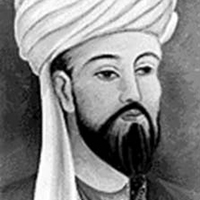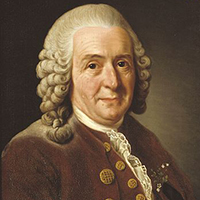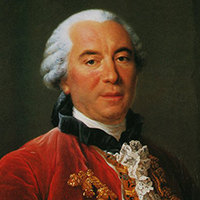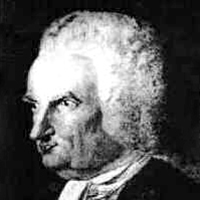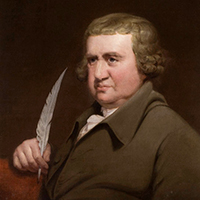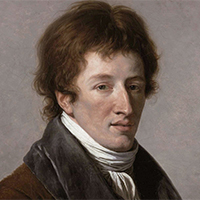

1201-1274
Nasīr al-Dīn al-TūsīNasīr al-Dīn al-Tūsī (1201-1274) develops a theory of evolution with organisms gaining differences through adapting to their environments. He suggests that organisms which gain beneficial new features quicker have advantages over others and are more variable.


1735
Carolus LinnaeusSwedish botanist, Carolus Linnaeus (1707-1778), develops the modern hierarchical classification system.


1749
Georges BuffonThe French naturalist Georges Buffon (1707-1788) envisages a constantly changing world in which species change over time (but rejects the idea that this change could lead to new species).


1773
James Burnett, Lord MonboddoJames Burnett, Lord Monboddo (1767-1792) suggests that humans descended from primates and that creatures can transform their characteristics in response to the environment over long time intervals.


1794
Erasmus DarwinErasmus Darwin (1731-1802) proposes that all warm-blooded animals arose and differentiated from a single form, and anticipates the idea of natural selection.


1795
Georges CuvierGeorges Cuvier (1769-1832) draws attention to the fact that the geological record is not a continuous one. He demonstrates the fact of extinction with studies of fossil mammals, and believes the extinctions to have occurred in a series of giant floods.
1809
Jean-Baptiste LamarckJean-Baptiste Lamarck (1744-1829) proposes that while simple forms of life were spontaneously generated, they were driven up a ladder of complexity over time. Use or disuse of organs and traits cause changes which could be passed on to the next generation.
1818
Robert Edmond Grant and Étienne Geoffroy Saint-HilaireRobert Edmond Grant (1793-1874) and Étienne Geoffroy Saint-Hilaire (1772-1844) further develop the ideas of Jean-Baptiste Lamarck & Erasmus Darwin to propose that plants and animals had a common evolutionary starting point (a view wrongly discredited by Richard Owen).
1830
Charles LyellCharles Lyell (1797-1875) establishes the basic chronology of the Tertiary period and its relationship to rock strata. He popularizes the doctrine of uniformitarianism; that the features of the Earth can be better explained as the long-term result of short-term geological phenomena.
1831
Charles DarwinCharles Darwin (1809-1882) sets off on HMS Beagle.
1845
Alexander von HumboldtAlexander von Humboldt (1769-1859) pioneers the study of ecology and initiates a new focus on the interactions between species and their environment.
1856
Neanderthal discoveryNeanderthal skull and bones are found in Neander valley in Germany.
1858
Alfred Russel WallaceAlfred Russel Wallace (1823-1913) independently conceives the theory of evolution by natural selection and co-publishes with Darwin on the subject.
1859
Charles DarwinCharles Darwin (1809-1882) publishes On the Origin of Species.
1860
Oxford Evolution DebateProponents and opponents of Darwin & Wallace’s theories clash in the famous Oxford Evolution Debate; Thomas Henry Huxley (1825-1895) and Samuel Wilberforce (1805-1873) butt heads in a public debate, which both sides consider a victory.
1866
Gregor MendelGregor Mendel (1822-1884) publishes Experiments in Plant Hybridisation, establishing some basic laws of the genetic inheritance of discrete traits. Mendel’s paper remained obscure for about 35 years, but in 1900 it was rediscovered.
1868
Ernst HaeckelErnst Haeckel (1834-1919) applies evolutionary theories to embryology. Subsequently, his work would provide early foundations for the field of evolutionary developmental biology or ‘evo devo’.
1871
Charles DarwinCharles Darwin (1809-1882) publishes The Descent of Man, and Selection in Relation to Sex.
1893
August WeissmanAugust Weissman (1834-1914) publishes his germ-plasm theory, which emphasises the separation of the germ line and soma.
1896
James Mark BaldwinJames Mark Baldwin (1861-1934) suggests that adaptation can arise and evolve from plasticity without invoking inheritance of acquired characters in A New Factor in Evolution, a concept later known as the Baldwin Effect. Similar ideas were also presented earlier or around the same time by Douglas Spalding, Conwy LLoyd Morgan and Henry Osborn.
1909
Wilhelm JohannsenWilhelm Johannsen (1857-1927), a Danish biologist, provides the basic terminology for genetics: ‘genes’ as particulate units of heredity; ‘genotype’ as the genetic constitution of an organism; and ‘phenotype’ as the organism’s physical characteristics.
1910
Thomas Hunt MorganThomas Hunt Morgan (1866-1945) establishes the chromosomal theory of heredity. Morgan began to breed and conduct experiments with the common fruit fly, Drosophila melanogaster, which initiated the field of experimental genetics. Morgan confirmed Mendelian laws of inheritance and the hypothesis that genes are located on chromosomes.
1918
Ronald FisherRonald Fisher (1890-1962) produces the paper The Correlation between Relatives on the Supposition of Mendelian Inheritance, showing how the continuous variation measured by biometricians could be the result of the action of many discrete genetic loci.
1925
Raymond DartRaymond Dart (1893-1988) publishes in Nature a description of the Taung child, a fossil skull from Taung near Johannesburg, of the species Australopithecus africanus.
1937
Theodosius DobzhanskyTheodosius Dobzhansky (1900-1975) publishes Genetics and the Origin of Species.
1942
Conrad Hal WaddingtonConrad Hal Waddington (1905-1975) proposes the evolutionary process of genetic assimilation in Canalization of Development and the Inheritance of Acquired Characters, followed by several other important papers and books, including The Strategy of Genes. His famous epigenetic landscape as a metaphor for gene regulation has become reprinted and re-interpreted ever since.
1942
Julian HuxleyJulian Huxley (1887-1975) publishes Evolution: The Modern Synthesis.
1942
Ernst MayrErnst Mayr (1904-2005) publishes Systematics and the Origin of Species in which he presents his influential ‘biological species concept’.
1950
Radiometric dating developedRadiometric dating techniques are developed during this decade.
1953
DNA structure discoveredFrancis Crick (1916-2004), James Watson (1928-) and Rosalind Franklin (1920-1958) discover the chemical structure of deoxyribonucleic acid (DNA) and show that it meets the unique requirements for a substance that encodes genetic information.
1960
mRNA discoveredSydney Brenner (1927-), Francis Crick (1916-2004), Francois Jacob (1920-2013) and Jacques Monod (1910-1976) discover mRNA.
1964
William HamiltonWilliam Hamilton (1936-2000) publishes his papers introducing inclusive fitness theory.
1974
Discovery of ‘Lucy’Paleontologists Don Johanson (1943-) and colleagues find ‘Lucy’, an almost complete Australopithecine female at Hadar, Ethiopia.
1975
Allan Wilson and Marie-Claire KingBerkeley biochemists Allan Wilson (1934-1991) and Marie-Claire King (1946-) show that humans share nearly 99% of their DNA with chimpanzees.
1984
Charles Sibley and Jon AhlquistCharles Sibley (1917-1998) and Jon Ahlquist (1944-) demonstrate that chimpanzees are more closely related to humans than to gorillas.
1990-2003
Human genome sequencedThe human genome is sequenced and assembled.
2003
Mary Jane West-EberhardMary Jane West-Eberhard (1941-) publishes Developmental Plasticity and Evolution, which focuses on the role of environmentally generated variation in evolution and speciation.
2010
Neanderthal genome sequencedRichard Green and colleagues publish a draft sequence of the Neanderthal genome, suggesting that that Neanderthals and modern humans interbred.
2018
The PresentExciting evolutionary biology research continues to this day.
